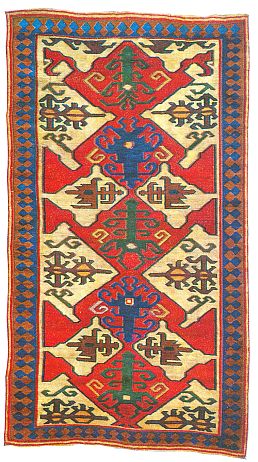One of the pieces that attracts me the most in this exhibition is the Bidjov with the out of scale field design.

Jerry makes the point in his gallery label that it is the over-sized character of the devices in the field of this relatively small rug that gives this design it's "dynamic power."
When I first saw this piece in the exhibition its out of scale drawing reminded me of another old piece in Schurmann.

Schurmann estimates that this piece is an 18th century Kazak. Jerry thinks his Bidjov may be 18th century too.
One factor rug analyses are almost always fallacious (we're often mistaken when relying on three or four) but the fact that these smallish rugs, estimated to be quite old, have field designs (unencumbered with many "filler" devices) the scale of which is much larger than one would expect in rugs of their size, makes me wonder whether in Caucasian rugs at least there might be some modest correlation between, smallish size, large scale field designs and age.
That thesis is too simplistic since we can pretty readily come up with other instances of small size and large scale design that seem younger.
For example, some time back as we were examining pieces from a TM rug morning, in which Joe Fell included this delicious Bidjar piece.

Here is a close look.

Fell estimated his Bidjar as 19th century.
This latter rug may also exemplify another reason why smaller piece sometimes have out-sized field designs. There is a species of sampler called a "strike-off" which is a small version of a planned larger rug with all the designs and dye colors used as is intended in the subsequent full-scale piece. It was suggested (and also debated) when we discussed this Joe Fell Bidjar that it might be a "strike-off" type sampler. Regardless, this possibility shows how difficult it is to relate with accuracy any given variable or two in oriental rugs with any other.
Nevertheless, I found the out of scale field design of the Bijov making me wonder whether it might not be a very old Caucasian rug before I read the gallery label.
Regards,
R. John Howe

 I would
disagree with Mr. Bennett, suggesting at least a first half of
19th.
I would
disagree with Mr. Bennett, suggesting at least a first half of
19th.
